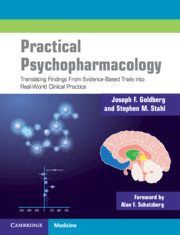 Practical Psychopharmacology
Practical Psychopharmacology Book contents
- Practical Psychopharmacology
- Practical Psychopharmacology
- Copyright page
- Dedication
- Contents
- Foreword
- Preface
- Abbreviations
- Part I General Principles
- Part II Targets of Pharmacotherapy
- 13 Disordered Mood and Affect
- 14 Disorders of Impulsivity, Compulsivity, and Aggression
- 15 Psychosis
- 16 Deficit States and Negative Symptoms
- 17 Anxiety
- 18 Addiction and the Reward Pathway
- 19 Trauma and Post-traumatic Stress Disorder
- 20 Personality Disorders and Traits
- 21 Cognition
- 22 Putting It All Together
- References
- Index
15 - Psychosis
from Part II - Targets of Pharmacotherapy
Published online by Cambridge University Press: 19 October 2021
- Practical Psychopharmacology
- Practical Psychopharmacology
- Copyright page
- Dedication
- Contents
- Foreword
- Preface
- Abbreviations
- Part I General Principles
- Part II Targets of Pharmacotherapy
- 13 Disordered Mood and Affect
- 14 Disorders of Impulsivity, Compulsivity, and Aggression
- 15 Psychosis
- 16 Deficit States and Negative Symptoms
- 17 Anxiety
- 18 Addiction and the Reward Pathway
- 19 Trauma and Post-traumatic Stress Disorder
- 20 Personality Disorders and Traits
- 21 Cognition
- 22 Putting It All Together
- References
- Index
Summary
Psychiatrist Thomas Szasz’s appraisal of the fundamental nature of psychosis underscores the magnitude of belief-conviction and cognitive rigidity with which false fixed beliefs and perceptions are espoused. Goals of pharmacological treatment for psychosis can target a number of domains: medications may loosen cognitive rigidity and dampen the intensity of false beliefs and perceptions (without necessarily rendering perceptions as conforming more accurately to objective reality); they may reduce the level of distress or agitation associated with psychosis (again without necessarily altering the inaccuracy that somehow sustains fixed false ideas and perceptions); they may improve social judgment (such that someone may acquire sufficient awareness, if not true insight, to recognize where and with whom psychotic phenomena should and should not be discussed); they may impose order on the form of thinking to allow a more linear (if not logical) process by which they reach conclusions; or, sometimes, medications may actually alter misperceptions and allow for greater concordance between external reality and one’s internal perception of it.
- Type
- Chapter
- Information
- Practical PsychopharmacologyTranslating Findings From Evidence-Based Trials into Real-World Clinical Practice, pp. 353 - 388Publisher: Cambridge University PressPrint publication year: 2021
